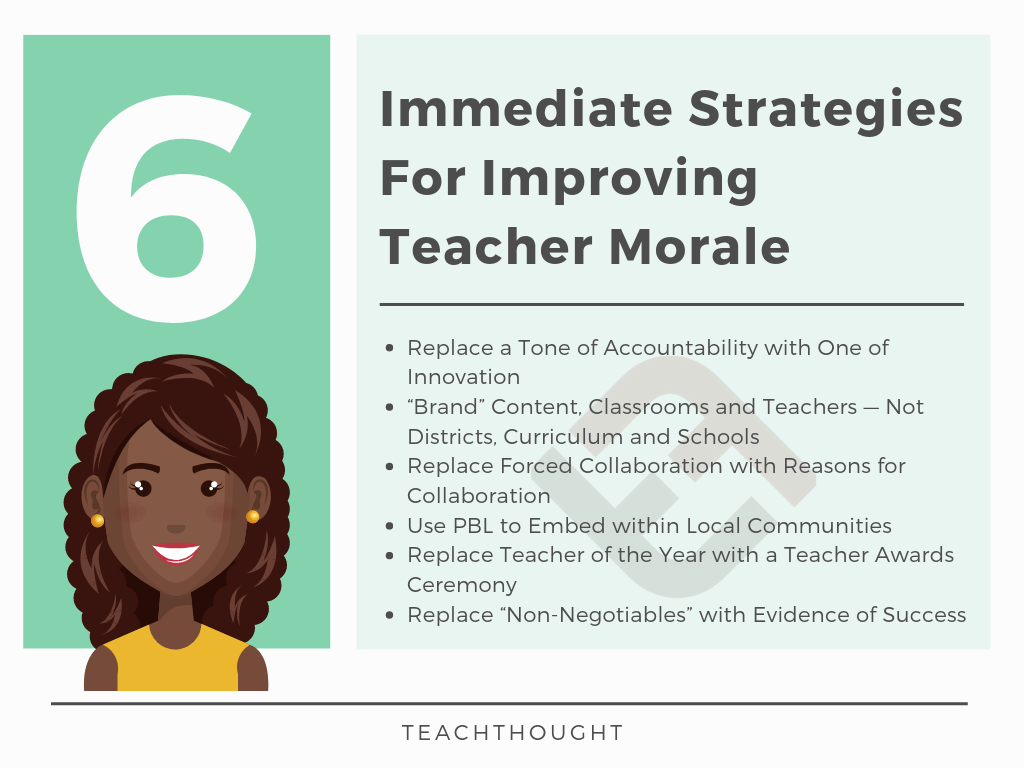
What Are The Best Immediate Strategies For Improving Teacher Morale?
by TeachThought Staff
Teacher morale isn’t a popular topic, and that makes sense on the surface. Teachers are professionals, like engineers, doctors, farmers or business leaders, and no one is going out of their way to make sure that engineers are ‘keeping their head up’ or that farmers ‘feel good about their craft.’
Further complicating matters, teachers ‘get summers off,’ and are at the helm of one of the most visibly struggling industries in the United States. Sympathy doesn’t come naturally under these circumstances.
It should be abundantly clear to anyone with experience around classrooms, teachers or students (which is to say almost all of us), that teaching is a highly emotional craft, loaded with possibility and expectation, importance and scale. It’s troubling when the National Commission on Teaching and America’s Future says that 46 percent of new teachers leave the profession within five years.
And even worse, this turnover is also impacting the whole public education machine — learning, teacher education, teacher training, funding, public perception, and so on — in a dizzying cause-effect pattern stuck on repeat. COVID-19 has only deepened this effect.
Fixing this issue is an illusion, as it’s not a single issue but rather a product of countless factors. However, there are six ways we can begin improving teacher morale here and now.
6 Immediate Strategies For Improving Teacher Morale
1. Replace a Tone of Accountability with One of Innovation
Schools — especially low-performing schools — often seek relief from pressure through alignment, adherence and compliance with a certain program, curriculum, set of standards, approach to faculty meetings, and so on. While there is nothing wrong with having standards and expecting teachers to stick to them, when this is done wrong it can create a climate of ‘accountability’ and ‘non-negotiables’ that requires all teachers to prove they are in compliance on a daily basis. And this is not an atmosphere of innovation or creativity.
2. Emphasize Content, Classrooms, and Teachers, Not Districts, Curriculum and Schools
Today, it is generally the district, a selected curriculum or the school itself that gets the “branding,” and is thus what parents and students discuss. To increase teacher morale, why not put the content areas (or unique classes based on those content areas), classrooms, and teachers at the center of attention? This goes against tradition, where teachers shy away from acclaim and spotlight, but maybe that — in one way or another — can change?
3. Replace Forced Collaboration with Reasons for Collaboration
Teacher collaboration — in person or in professional learning communities and networks online — is a huge catalyst for teacher improvement. But forcing teachers to collaborate works about as well as forcing students to learn. Just as project-based learning works best under the duress of an authentic need-to-know, teacher collaboration works best under a similar need-to-collaborate, not through forced and externally-driven ‘data teams.’
4. Use PBL to Embed within Local Communities
This would help with the branding mentioned above, but more importantly, it would put teachers in contact with the stakeholders they are most accountable to: the local community.
5. Replace Teacher of the Year with a Teacher–Or Student–Awards Ceremony
Teacher of the Year ceremonies celebrate teaching by celebrating one teacher. Why not celebrate all teachers — and do so in some merit-based way rather than the ‘everybody gets a ribbon’ model?
I’m less enthusiastic about this idea in general, mainly because most of the teachers I work with are less interested in awards than they are student achievement. But maybe modesty and redirection isn’t the best approach here?
6. Promote Diverse Evidence of Success
There’s a clear need for school districts to document those rules and regulations that are ‘non-negotiable.’ Autonomy is one thing, but teachers doing whatever they want whenever they want is a pathway to failure. So what if we replaced the goals of said rules (academic success in most cases) with something else?
Let’s try evidence of success with a focus on the persistent visibility of student work, and let’s train those who do ‘walk-throughs’ to more efficiently navigate that work.
The Way Forward
Teacher morale is not a hot-button topic, but it matters. Teachers — great teachers, anyway — touch every part of the learning process. Bearing down on them with out-of-proportion expectations and accountability hasn’t led to particularly sterling results. But here’s what can lead to such outcomes:
Rebranding teachers as passionate mediators of exciting content
Reconnecting with local communities in substantive ways
Seeking — and supporting — innovation rather than compliance from teachers
Rediscovering the human elements of teaching and learning is among the most powerful pathways forward.
This article was written by Terry Heick and originally published at edutopia
